When I decided to write an article about the best aquarium plants for beginners, first of all I’ve studied the ones that Google search provided me with. You can’t imagine, how I was surprised – it’s been quite a while since I’ve read so many ridiculous ideas and tips. Large part of the plants which are recommended for beginners in those articles, are challenging to keep even for experienced aquarists. I know it, since I’ve tried doing this many times and not always it was a success.
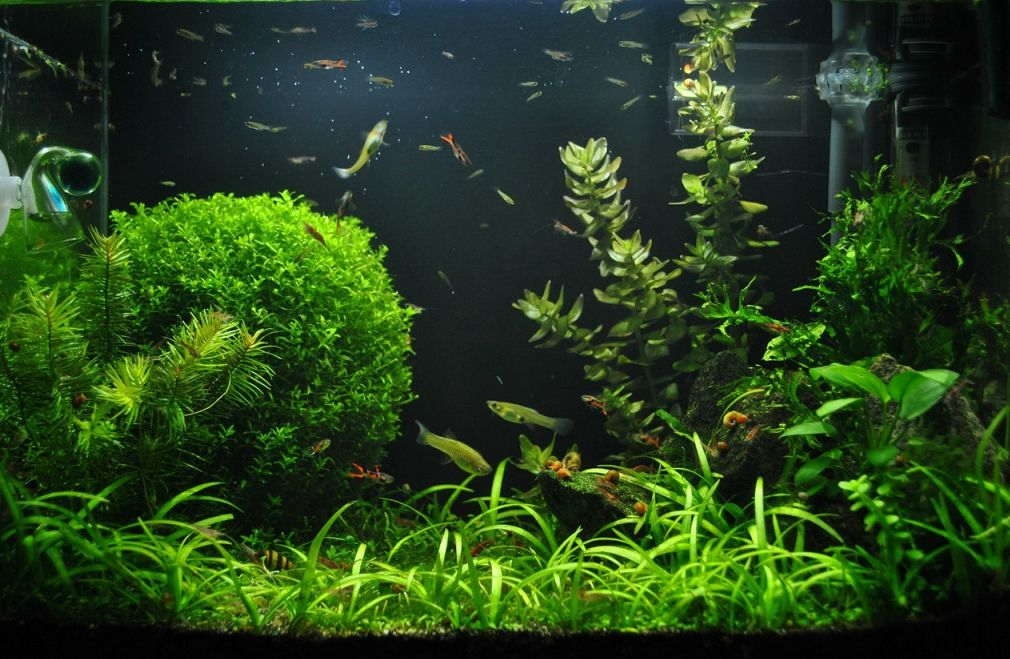
Contents
Beginner-Friendly Aquatic Plant Selections
What do I mean when talking about the best for beginner aquarists? These plants should be able to quickly adapt to new tank conditions, show stable growth rate, be able to stand abrupt changes of the water parameters and withstand algae fouling.
Below I will give a list of top-10, which are quite hard to kill and which grow fast provided almost with any tank water parameters, without additional CO2 supply and mineral fertilizers.
These are the most practical aquarium plants for beginners in my opinion. Actually, the list could be much longer, because there are far more unpretentious species. However, not all of them can be found on sale.
How to select plants for beginner aquarists?
When choosing aquarium plants, especially for beginners, there are several important criteria to consider. Here are the key factors that make a plant species ideal for a low-maintenance tank:
- Tolerance to various water conditions: A hardy plant can thrive in a wide range of water hardness, from 4 to 20 degrees. Since many beginners don’t measure water hardness or temperature consistently, it’s important to choose plants that can adapt to these fluctuations.
- Low lighting requirements: Most commercial aquarium setups come with low-power lighting, as this keeps the cost down. Beginner-friendly plants should be able to grow in low-light conditions, thriving even when lighting is less than optimal.
- Resilience to sudden changes: Beginners may neglect their tanks for weeks or even months. During this time, the water’s pH and other parameters can change significantly. Hardy plants can withstand these sudden shifts and bounce back when the tank is eventually cleaned or when water is replaced.
- Minimal maintenance needs: Some plants will continue to grow without regular care. After a few months of neglect, they may become overgrown or shaded, but they won’t die off quickly. These plants can survive without regular trimming, fertilization, or attention, making them perfect for beginners who may forget to maintain their tanks.
- Resistance to algae growth: Algae can be a common problem for new aquarists. Plants that are resilient to algae fouling will survive long enough for the owner to notice and address the issue, offering time for intervention without the plant deteriorating quickly.
Best beginner plants for aquarium
Java moss
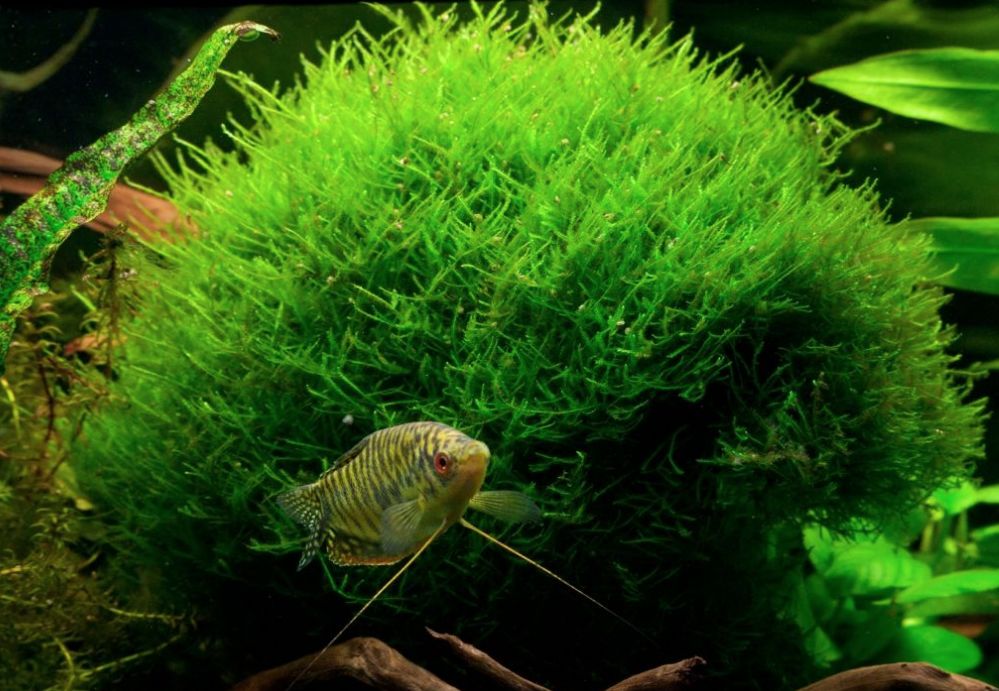
All aquarium mosses are rather undemanding, though they have low growth rate. Java moss is a hardy, dark-green moss that forms dense, tangled strands. Its standout feature is its impressive ability to thrive in low-light conditions, making it perfect for newly established tanks. One of the best aspects of Java moss is that it doesn’t require planting in the substrate since it doesn’t have roots. Instead, it can easily attach itself to stones, driftwood, and other decorations in your aquarium. This natural attachment creates a beautiful, organic look in your tank.
To keep your Java moss securely in place, you can use a thin thread or pin it to the bottom of the tank. This will ensure that it stays put despite any water movement or curious fish.
However, it’s important to keep the water clean. Dirty water can cause debris to accumulate on the moss, forming a thick layer that inhibits its ability to “breathe” and perform photosynthesis effectively. This can lead to a decline in the moss’s health.
However, very dirty water may ruin the moss, when suspended organics will settle on its leaves and create a thick layer on them. Thus, the moss will be unable to breathe and due to this the photosynthesis process worsens.
| Aspect | Description |
|---|---|
| Scientific Name | Taxiphyllum barbieri |
| Appearance | Small, delicate moss with branching stems and tiny, pointy leaves |
| Growth Rate | Slow to moderate growth rate, suitable for low-tech setups |
| Light Requirements | Can tolerate low to moderate lighting conditions, but thrives under medium to high light |
| CO2 Requirement | Can thrive without CO2 supplementation, but benefits from CO2 injection for faster and denser growth |
| Water Parameters | Temperature: 68-82°F (20-28°C); pH: 5.0-8.0; soft to moderately hard water |
| Attachment | Attaches to various surfaces like rocks, driftwood, and aquarium decorations |
| Maintenance Level | Low-maintenance plant; requires occasional trimming to prevent overgrowth |
| Propagation Methods | Easily propagated by cutting and reattaching stems or removing portions of the moss |
| Versatility | Suitable for aquariums, terrariums, and paludariums; provides hiding spots for small aquatic species |
| Benefits | Enhances water quality by absorbing excess nutrients and providing shelter for fry and small fish |
| Common Uses | Aquascaping, creating moss walls, attaching to rocks and driftwood for natural-looking setups |
Vallisneria
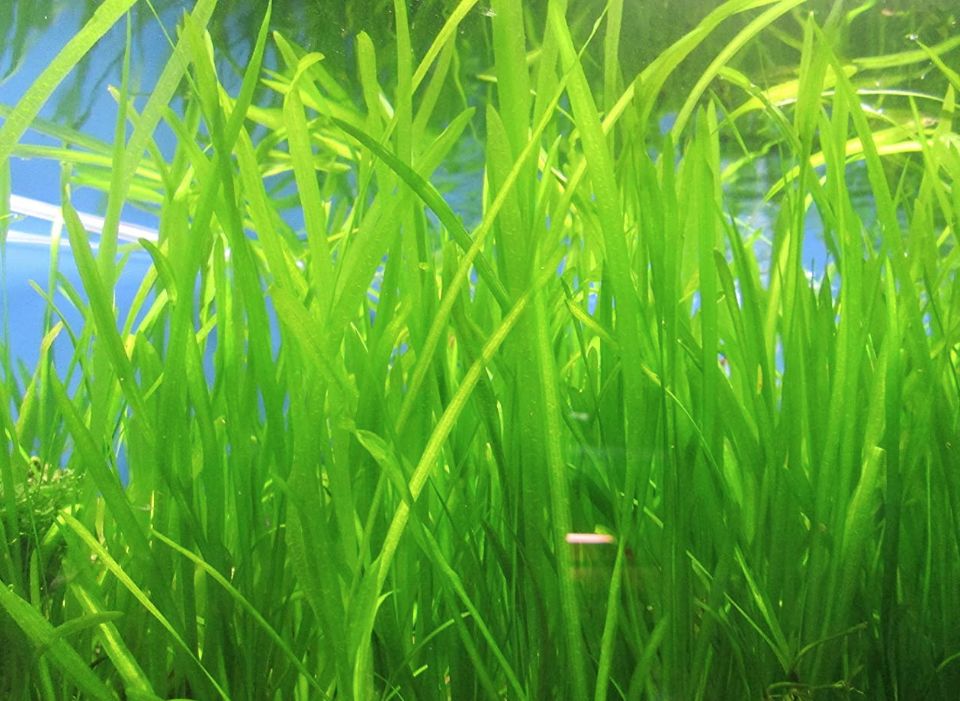
Vallisneria is extremely undemanding and grows rapidly. There are lots of Vallisneria species. However, there are only three of them that are used for aquariums decoration. These are: Vallisneria spiralis, Vallisneria sp. Gigantea and Vallisneria nana.
Vallisneria can grow up to 50 cm tall, while Vallisneria sp. Gigantea – up to 2 m tall. If the plant has reached the tank top, it starts to trail along its surface. However, you mustn’t trim Vallisneria, since tips of its leaves will start to rot! If the vegetation becomes too thick, it is recommended to weed it.
| Aspect | Vallisneria spiralis | Vallisneria americana | Vallisneria nana |
|---|---|---|---|
| Common Names | Straight Vallisneria | Tape Grass, American Vallis, Jungle Vallisneria | Dwarf Vallisneria |
| Leaf Shape | Long, narrow and straight | Long, narrow and straight | Narrow |
| Maximum Height | Up to 2 feet (60 cm) | Up to 2 feet (60 cm) | Up to 10 inches (25 cm) |
| Growth Rate | Moderate to fast | Moderate to fast | Slow to moderate |
| Light Requirements | Moderate to high | Moderate to high | Low to moderate |
| CO2 Requirement | Can thrive without CO2 | Can thrive without CO2 | Can thrive without CO2 |
| Water Temperature | 68-82°F (20-28°C) | 60-82°F (15-28°C) | 68-82°F (20-28°C) |
| pH Range | 6.5-8.0 | 6.0-8.0 | 6.0-8.0 |
| Hardiness | Hardy | Hardy | Hardy |
| Propagation | Runners, plantlets | Runners, plantlets | Runners, plantlets |
| Ideal Placement | Background or midground | Background or midground | Midground |
| Suitable for Small Tanks | Not recommended | Not recommended | Yes |
| Ideal for Low-Tech Setups | Yes | Yes | Yes |
| Benefits | Oxygenates water, provides | Oxygenates water, provides | Adds texture to aquascapes, |
| Commonly Available | Yes | Yes | Yes |
Hornwort
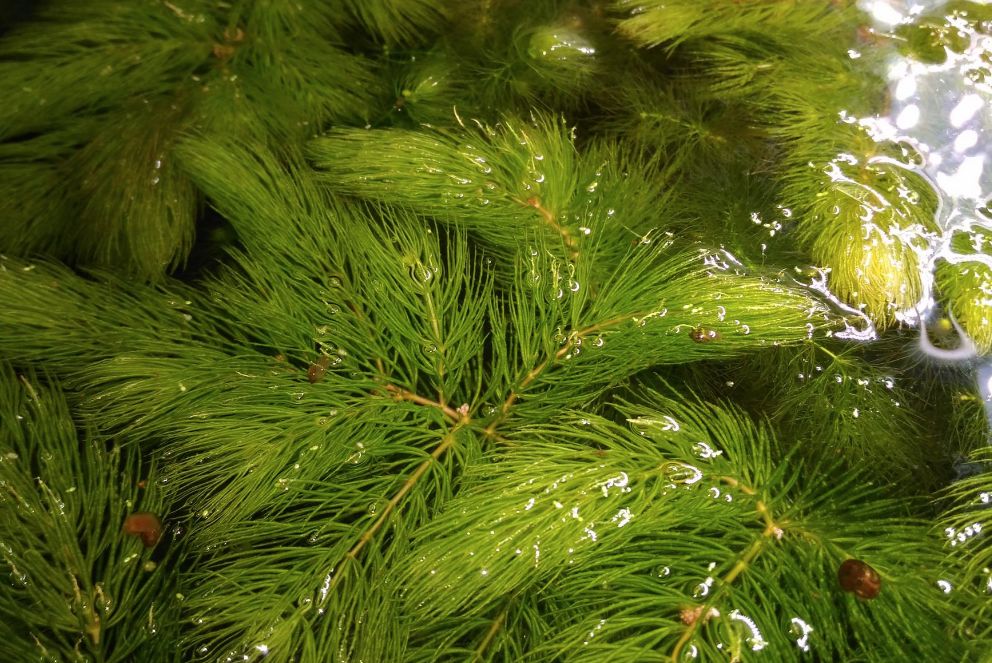
While Java moss should be fixed to the tank decorations, Vallisneria has to be planted into the bottom substrate, hornwort doesn’t need any of these. Hornwort can be both planted or just left to float in the water. In time you will have so many of its shoots in the tank.
Hornwort acts as a filter in a tank. This plant enriches the tank water with oxygen and absorbs nitrates from it. Also this plant works on principle of mechanical filter – it captures suspended matter. If you see that the roots has become muddy, you should wash it under the running water.
Hornwort grows at water temperature range from 20 to 30 degrees. If the temperature is close to 30 degrees, then hornwort may start growing faster and grow up to 20 cm in a week. The plant doesn’t require mineral fertilizers provided with weekly renew of ¼ of tank water.
The plant propagates by means of cutting its stem. Even if you have a tiny piece of the stem, you can grow the whole plant from it.
| Aspect | Hornwort |
|---|---|
| Common Names | Hornwort, Coontail |
| Appearance | Long, slender, branching stems |
| Leaf Shape | Fine, needle-like leaves |
| Maximum Height | Up to 24 inches (60 cm) |
| Growth Rate | Fast |
| Light Requirements | Low to high |
| CO2 Requirement | Can thrive without CO2 |
| Water Temperature | 59-86°F (15-30°C) |
| pH Range | 6.0-8.0 |
| Hardiness | Very Hardy |
| Propagation | Fragmentation, side shoots |
| Ideal Placement | Background or floating |
| Suitable for Small Tanks | Yes |
| Ideal for Low-Tech Setups | Yes |
| Benefits | Oxygenates water, absorbs excess nutrients, provides hiding places for fry and small fish |
| Commonly Available | Yes |
Java fern
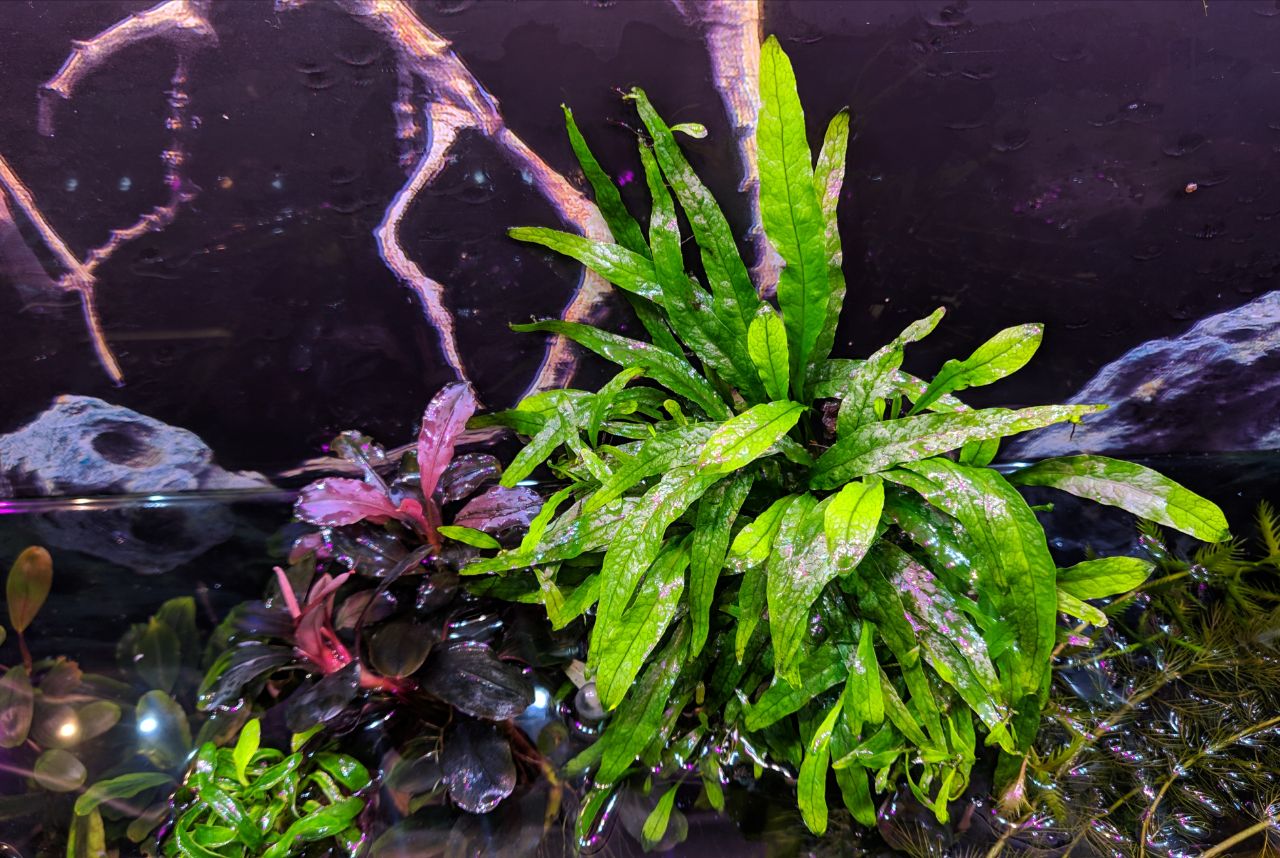
This is not very tall and rather undemanding plant which has rather low growth rate (just like all other fern species). The Java fern doesn’t have roots and it doesn’t require planting into the bottom substrate; however, by means of its root-like formations – rhizoids – it easily sticks to stones, snags, etc. The java fern can be used as a basis for very good looking aquascape compositions.
This fern is easy to keep. It can adapt to various conditions. The plant is not demanding in terms of lighting level, hydrochemical composition of the tank water and it can stand low temperatures up to 4 °C.
It is recommended to fix the plant with a sea-line, special collars or glue on stones, snags and other decorations with rough surface.
If the roots get into the substrate, they will rot. All you can do in this respect, is slightly press the plant with a small stone to the tank bottom, so it won’t float.
| Aspect | Java Fern (Standard) | Java Fern (Windelov) | Java Fern (Narrow Leaf) |
|---|---|---|---|
| Leaf Shape | Broad, ruffled leaves | Ruffled and more branched | Narrow and elongated leaves |
| Maximum Height | Up to 12 inches (30 cm) | Up to 8 inches (20 cm) | Up to 12 inches (30 cm) |
| Growth Rate | Slow to moderate | Slow to moderate | Slow to moderate |
| Light Requirements | Low to moderate | Low to moderate | Low to moderate |
| CO2 Requirement | Can thrive without CO2 | Can thrive without CO2 | Can thrive without CO2 |
| Water Temperature | 68-82°F (20-28°C) | 68-82°F (20-28°C) | 68-82°F (20-28°C) |
| pH Range | 6.0-7.5 | 6.0-7.5 | 6.0-7.5 |
| Hardiness | Very Hardy | Very Hardy | Very Hardy |
| Propagation | Rhizome division | Rhizome division | Rhizome division |
| Ideal Placement | Midground or background | Midground or background | Midground or background |
| Suitable for Small Tanks | Yes | Yes | Yes |
| Ideal for Low-Tech Setups | Yes | Yes | Yes |
| Commonly Available | Yes | Yes | Yes |
Anubias nana
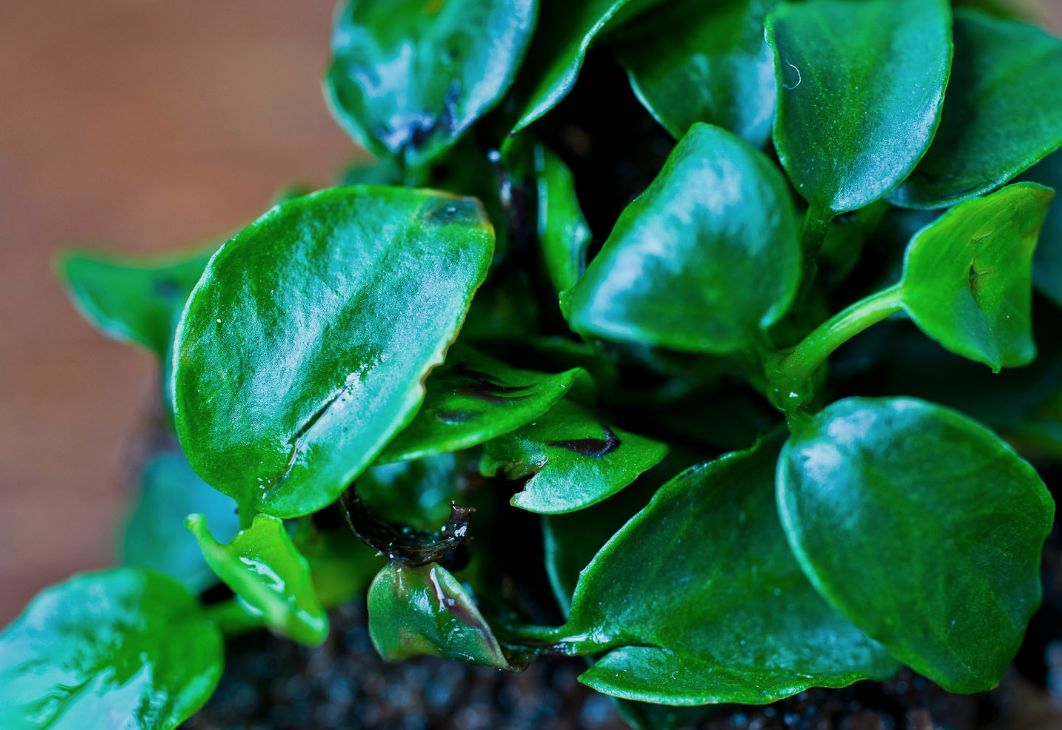
Anubias species are not the cheap ones to buy, since they grow slowly; however, they are rather enduring and they will do with low light level. Besides, the plant is too tough for many herbivorous fish species.
Anubias should be planted so, that its roots are in the substrate and the stem is above it. You can fix the roots to a snag or a stone and leave some of them out of the substrate. Even in this case the anubias will grow successfully.
The most popular Anubias species is anubias nana. It grows good at moderate lighting, doesn’t react to changes of water pH and hardness. Anubias has coarse leaves, that’s why fishes and snails can’t do them any harm.
As for the demerits, we should mention its low growth rate and the fact that it can’t stand algae fouling.
| Scientific Name | Anubias barteri var. nana |
| Genus | Anubias |
| Family | Araceae |
| Common names | Anubias Nana; Dwarf anubias |
| Plant Type | Rhizomatous |
| Lighting Needs | Low to Moderate |
| Growth rate | Slow |
| CO2 | Not required, but beneficial |
| Temperature Required | 22-28 °C (72-82 °F) |
| pH Level | 6.0-7.5 |
| KH | 3-10 |
| Care Level | Easy |
| Minimum tank size | 10 gallons |
| Maximum plant size | Up to 4 inches (10 cm) |
Amazon sword
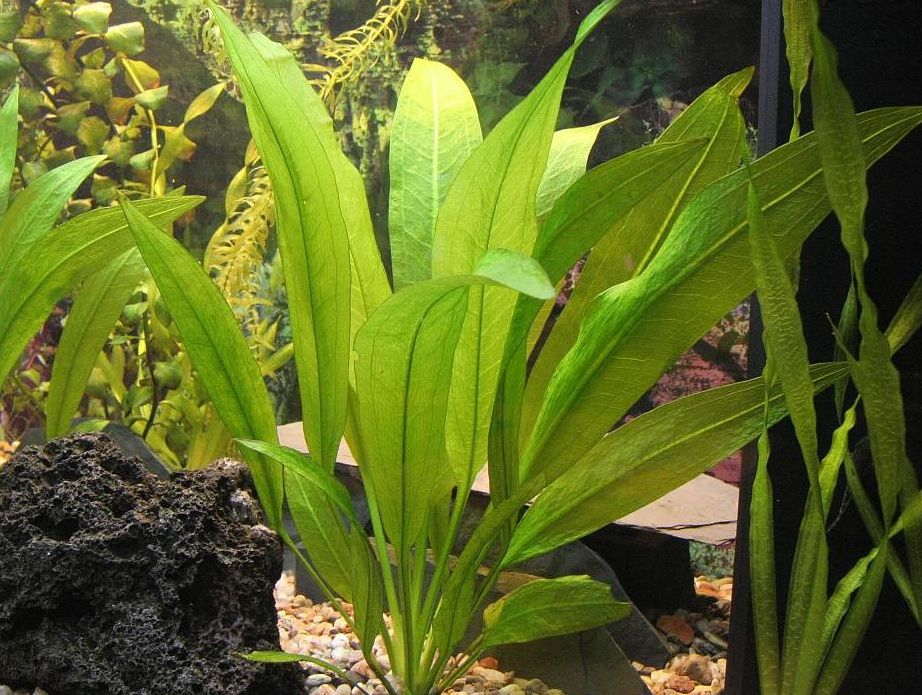
If you wish to have not just chaotic tangles of small leaves in a tank, but some large plants with rather wide leaves, then Amazon sword is a perfect for you. In general, there are many nice and undemanding kinds among Echinodorus species, but Amazon sword is the most popular one.
It is easy to take care of, grows very fast and becomes a rather good-looking. It may appear rather spectacular, if you plant it in a proper place. Amazon sword may grow up to 40 cm tall, that’s why it is better to plant it in the middle of the tank or in the back.
Due to its rather significant size, the Amazon sword is a good decoration for large sized tanks.
| Family | Alismataceae |
| Scientific Name | Echinodorus grisebachii; Echinodorus amazonicus; Echinodorus bleheri |
| Common Names | Amazon sword, Sword plant |
| Origin | Brazil, South America |
| Placement | Mid ground or Background Plant |
| Maximum Size | up to 16 Inches |
| Care Level | Easy |
| Growth Rate | Moderate |
| Propagation | Vegetative; runners |
| Feed Type | Root Feeder |
| CO2 Requirement | No |
| Lighting | Mild to moderate |
| Flow Rate | Low |
| Temperature Range | 60.8-82.4°F |
| pH Range | 6.5 – 7.5 |
Amazon frogbit
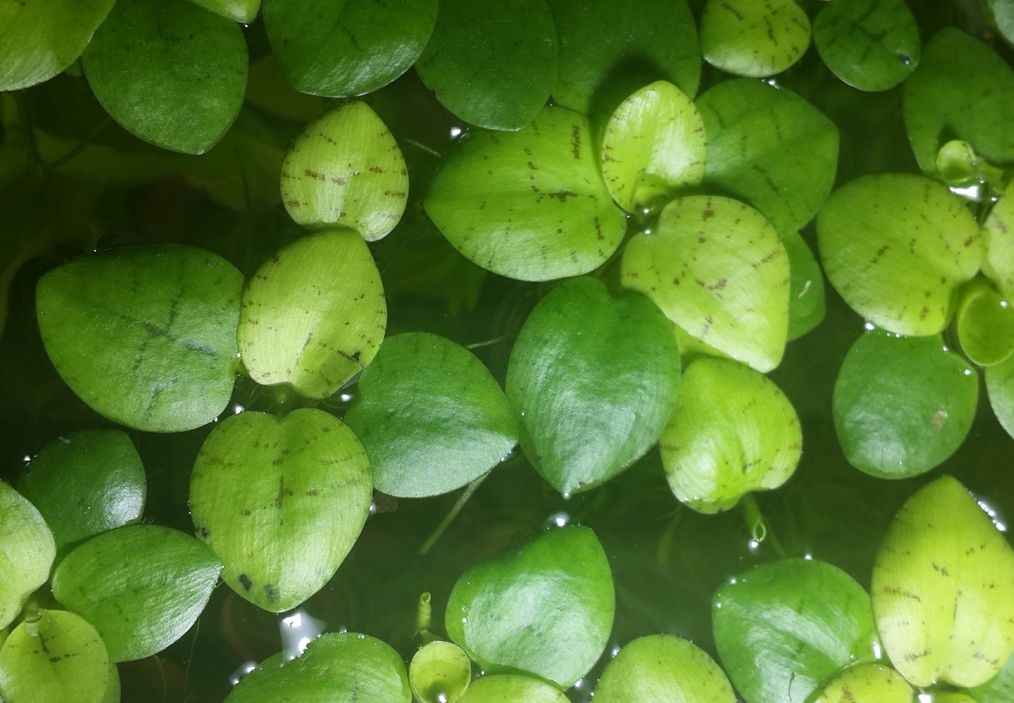
All fluctuant plants are rather undemanding and they require only bright light. It is hard to choose just one, since all of them have rather significant decorative properties. I prefer Amazon frogbit for a couple of reasons – it has long and nice roots, which decorate the middle water layer in a tank and the plant grows new shoots extremely quickly.
Like most of fluctuant plants Amazon frogbit requires bright light, though for some period of time it is able to dwell in shadowed areas. It doesn’t need mineral fertilization.
The plant propagates by growing the new shoots at the end of its branch-shoots. Once these new shoots grow at least three leaves and a root, you can separate them from the parent.
| Scientific Name | Limnobium laevigatum |
| Family | Hydrocharitaceae |
| Common names | Amazon frogbit |
| Native To | USA |
| Lighting Needs | Hight |
| Growth rate | Hight |
| CO2 | No |
| Fertilizers | Yes |
| Temperature Required | 20-30 °C |
| pH Level | 6.0-7.5 |
| Care Level | Moderately demanding |
| Placement in Tank | Floating plant |
| Maximum plant size | leaves are 1,5-3 cm long and up to 0,5 cm thick |
Cryptocorynes
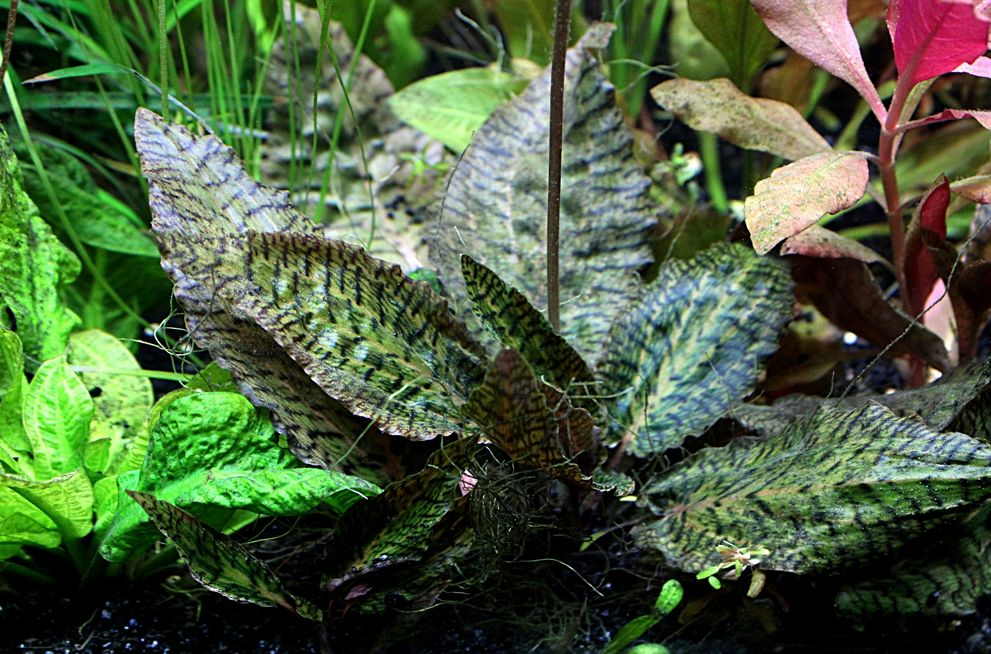
Cryptocoryne is a very widespread aquarium plant, but various kinds of the plant require different tank conditions. It is quite challenging to recommend some specific Cryptocoryne species to keep in an aquarium, therefore try to read about the most renowned species of the plant and choose the one you like yourself.
Cryptocoryne species don’t like replanting, since in a new place will grow new leaves only in a several months, even provided with proper care.
Cryptocorynes propagate by means of trailing and some of their new shoots may be in the substrate. A small leaf that forms at the end of the shoot grows into a small bush in time. Once the bush has 5-6 leaves in it and it is several weeks old – you can replant it.
| Aspect | Cryptocoryne wendtii | Cryptocoryne balansae | Cryptocoryne spiralis |
|---|---|---|---|
| Common Names | Wendt’s Cryptocoryne | Balansae Cryptocoryne | Spiral Cryptocoryne |
| Leaf Shape | Broad, elongated, wavy | Long, narrow, undulated | Narrow, spiral |
| Maximum Height | Up to 6 inches (15 cm) | Up to 20 inches (50 cm) | Up to 12 inches (30 cm) |
| Growth Rate | Moderate to slow | Moderate to slow | Slow to moderate |
| Light Requirements | Low to moderate | Moderate to high | Moderate to high |
| CO2 Requirement | Can thrive without CO2 | Can benefit from CO2 | Can benefit from CO2 |
| Water Temperature | 72-82°F (22-28°C) | 72-82°F (22-28°C) | 72-82°F (22-28°C) |
| pH Range | 6.0-7.5 | 6.0-7.5 | 6.0-7.5 |
| Hardiness | Very Hardy | Hardy to Very Hardy | Very Hardy |
| Propagation | Rhizome division, runners | Rhizome division, runners | Rhizome division, runners |
| Ideal Placement | Midground or background | Background or midground | Background or midground |
| Suitable for Small Tanks | Yes | No | Yes |
| Ideal for Low-Tech Setups | Yes | Yes | Yes |
| Commonly Available | Yes | Yes | Yes |
Marimo moss
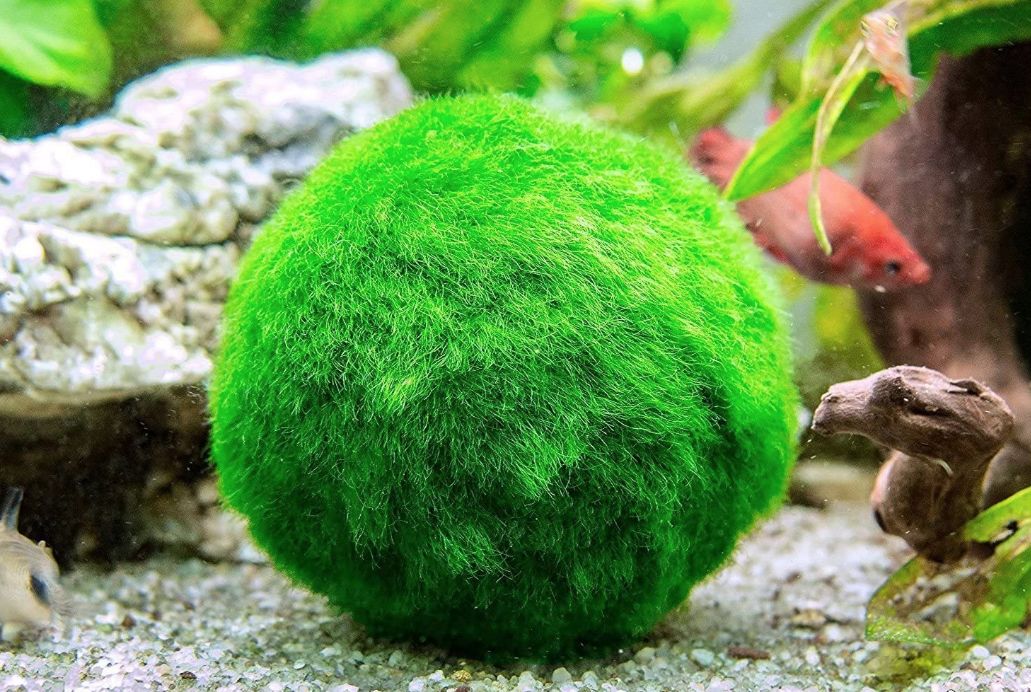
This is one of the most popular aquarium plants for beginners. Really, we can name only its advantages – the plant cleans water, has unusual shape, stable growth rate and serves as a shelter for shrimps.
However, there is one sufficient drawback, which made me doubt if I should include Marimo Moss into my list.
The moss likes cold water and in warm water it starts to fall into pieces and divides into parts. This way the plant propagates in the wild. Yet, I decided to include it into the list, since according to my experience of keeping Marimo moss balls in my tank, the marimo moss adapts quite well and maintains its attractive shape.
| Aspect | Japanese Marimo Moss Ball |
|---|---|
| Common Names | Marimo Ball, Moss Ball |
| Appearance | Round, ball-shaped moss |
| Texture | Soft and velvety |
| Size Range | Typically 0.6 to 2.4 inches |
| Growth Rate | Slow |
| Light Requirements | Low to moderate |
| CO2 Requirement | Can thrive without CO2 |
| Water Temperature | 68-82°F (20-28°C) |
| pH Range | 6.0-8.0 |
| Hardiness | Very Hardy |
| Propagation | Division, cuttings |
| Ideal Placement | Floating or anchored |
| Suitable for Small Tanks | Yes |
| Ideal for Low-Tech Setups | Yes |
| Benefits | Natural filtration, oxygenation, low maintenance, unique and charming appearance |
| Commonly Available | Yes |
Egeria densa
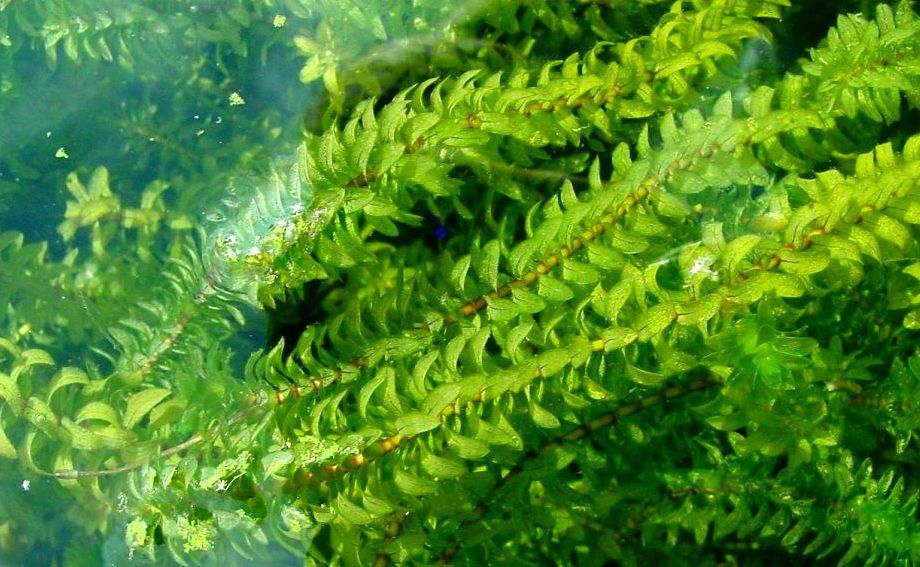
In the wild you can encounter Egeria densa in waters of North and South America. However, when the plant grows widely it becomes rather aggressive and pushes out the rest of the flora representatives. Due to such behavior the plant got its name ‘Waterweed’.
In a tank Egeria densa feels rather comfortable as well, it cleans water and upgrades the space in the tank. The plant is rather unpretentious, therefore it’s not difficult to take care of it. Both beginner aquarists and professionals like it.
Egeria densa grows quickly and its shoots my be up to 2 meters long. You can trim the shoots up to the length proper for your tank. The roots are thin, fragile and long.
| Aspect | Egeria densa |
|---|---|
| Common Names | Brazilian Waterweed, Anacharis |
| Leaf Shape | Elongated, narrow leaves |
| Maximum Height | Up to 3 feet (90 cm) |
| Growth Rate | Fast |
| Light Requirements | Moderate to high |
| CO2 Requirement | Can benefit from CO2 |
| Water Temperature | 59-86°F (15-30°C) |
| pH Range | 6.5-7.5 |
| Hardiness | Very Hardy |
| Propagation | Stem cuttings, side shoots |
| Ideal Placement | Background |
| Suitable for Small Tanks | Yes |
| Ideal for Low-Tech Setups | Yes |
| Benefits | Oxygenates water, absorbs excess nutrients, provides hiding places for fish and fry |
| Commonly Available | Yes |